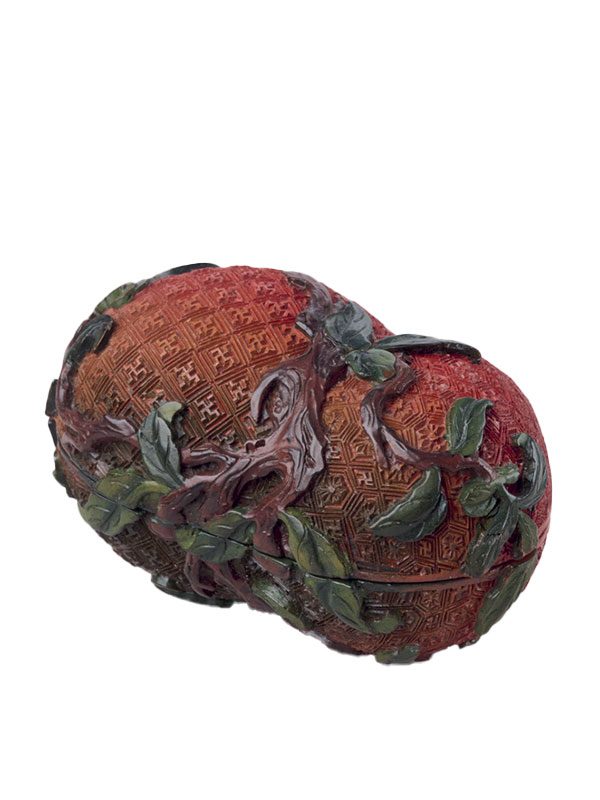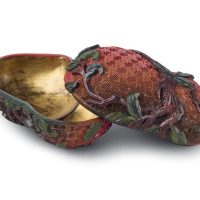Lacquer box in the form of two peaches
China, second half 18th century
A small lacquer box in the form of two conjoined peaches. The box is carved in relief with minutely detailed stalks and blossoms in green, brown and yellow lacquer. The peaches are carved in low-relief diaper pattern, one with wan symbols the other with hexagonal starburst pattern, interspersed with tiny wan symbols. The interior is covered in a thin layer of gilding on a black lacquer base, which partly shows through the gilding.
This beautifully carved and detailed lacquer box is covered in layers of coloured lacquer to resemble two peaches. The graduation from green to red on the side of the box is particularly well executed and enhances the sense of great realism. Huang Cheng gives the following account of the multi-colour carved lacquer technique in the publication Xiushi lu (…) in the late Ming dynasty: “Multi-colour carved lacquer (ticai) is mostly formed by layers of cinnabar, such as red lacquered flowers accompanied by green lacquered leaves, purple lacquered vines associated with yellow lacquered fruits, colourful lacquered clouds above black lacquered stones etc.”[1] The form of the present box, representing two peaches, references immortality: the word for peach (tao) can also mean: ‘May you live long’ and to have two peaches doubles this sentiment.[2] The wan (‘ten thousand’) character is a good luck symbol and the combination of peaches, peach blossoms (taohua) and wan symbols therefore expresses the wish ‘May your ten thousand longevities be without limit’.[3] In shape, decoration and proportion this fine little box can be closely compared to an example in the Qing Court collection at the National Palace Museum, Taipei.[4] The striking similarity suggests that the present box was produced in the same workshop. A closely related lacquer box in the shape of a melon is in the Muwen Tang collection.[5]
Provenance:
Ben Janssens Oriental Art, October 2012
Private Collection, UK
1 Kwan, S. Chinese Lacquer, The Muwen Tang Collection Series, Vol. 20, Hong Kong, 2010, p. 318
2 Tse Bartholomew, T. Hidden Meanings in Chinese Art, Asian Art Museum, San Francisco, 2006, 7.44.1, p. 204
3 Tse Bartholomew, T. op. cit. no. 7.59.4, p. 226
4 Carving the Subtle Radiance of Colors: Treasured Lacquerware in the National Palace Museum in the National Palace Museum, Taipei, 1999, no. 008F, p. 27
5 Kwan, S. op. cit. no. 117, pp. 318-9
清/三色剔红双桃形盒
桃子在中国传统文化中是长寿的象征,桃形器在清代漆器中亦十分常见。此盒呈双桃形,平底。其通体髹以红漆,双桃分别雕以锦地纹及万字纹为地,雕工锋利清晰。盒盖之上雕以桃花及枝叶,其中枝叶部分分别呈现褐色及绿色,刻画细致。


